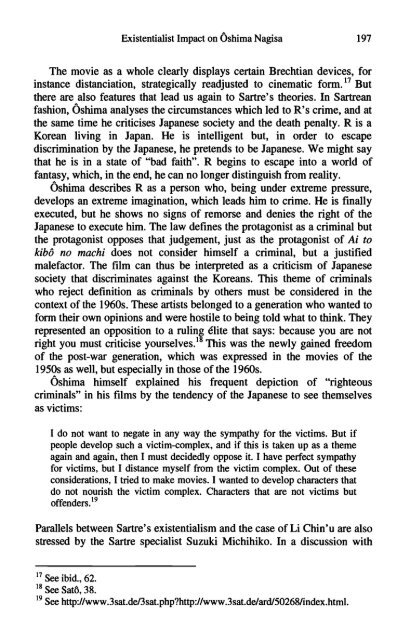Sartre's second century
Sartre's second century
Sartre's second century
Create successful ePaper yourself
Turn your PDF publications into a flip-book with our unique Google optimized e-Paper software.
Existentialist Impact on 6shima Nagisa 197<br />
The movie as a whole clearly displays certain Brechtian devices, for<br />
instance distanciation, strategically readjusted to cinematic form. 17 But<br />
there are also features that lead us again to <strong>Sartre's</strong> theories. In Sartrean<br />
fashion, Oshima analyses the circumstances which led to R's crime, and at<br />
the same time he criticises Japanese society and the death penalty. R is a<br />
Korean living in Japan. He is intelligent but, in order to escape<br />
discrimination by the Japanese, he pretends to be Japanese. We might say<br />
that he is in a state of "bad faith". R begins to escape into a world of<br />
fantasy, which, in the end, he can no longer distinguish from reality.<br />
Oshima describes R as a person who, being under extreme pressure,<br />
develops an extreme imagination, which leads him to crime. He is finally<br />
executed, but he shows no signs of remorse and denies the right of the<br />
Japanese to execute him. The law defines the protagonist as a criminal but<br />
the protagonist opposes that judgement, just as the protagonist of Ai to<br />
kibo no machi does not consider himself a criminal, but a justified<br />
malefactor. The film can thus be interpreted as a criticism of Japanese<br />
society that discriminates against the Koreans. This theme of criminals<br />
who reject definition as criminals by others must be considered in the<br />
context of the 1960s. These artists belonged to a generation who wanted to<br />
form their own opinions and were hostile to being told what to think. They<br />
represented an opposition to a ruling £lite that says: because you are not<br />
right you must criticise yourselves. 18 This was the newly gained freedom<br />
of the post-war generation, which was expressed in the movies of the<br />
1950s as well, but especially in those of the 1960s.<br />
Oshima himself explained his frequent depiction of "righteous<br />
criminals" in his films by the tendency of the Japanese to see themselves<br />
as victims:<br />
I do not want to negate in any way the sympathy for the victims. But if<br />
people develop such a victim-complex, and if this is taken up as a theme<br />
again and again, then I must decidedly oppose it. I have perfect sympathy<br />
for victims, but I distance myself from the victim complex. Out of these<br />
considerations, I tried to make movies. I wanted to develop characters that<br />
do not nourish the victim complex. Characters that are not victims but<br />
offenders. 19<br />
Parallels between <strong>Sartre's</strong> existentialism and the case of Li Chin'u are also<br />
stressed by the Sartre specialist Suzuki Michihiko. In a discussion with<br />
17 See ibid., 62.<br />
18 See Sat6,38.<br />
19 Seehttp://www.3sat.de/3sat.php?http://www.3sat.de/ard/50268/index.html.
















